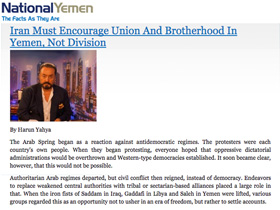
The Arab Spring began as a reaction against antidemocratic regimes. The protesters were each country’s own people. When they began protesting, everyone hoped that oppressive dictatorial administrations would be overthrown and Western-type democracies established. It soon became clear, however, that this would not be possible.
Authoritarian Arab regimes departed, but civil conflict then reigned, instead of democracy. Endeavors to replace weakened central authorities with tribal or sectarian-based alliances placed a large role in that. When the iron fists of Saddam in Iraq, Gaddafi in Libya and Saleh in Yemen were lifted, various groups regarded this as an opportunity not to usher in an era of freedom, but rather to settle accounts.
The main factor in the wave of violence in the Arab world is that Arab countries are composed of different ethnic and sectarian groups. However, there have always been external elements activating that factor.
The Sykes-Picot Treaty signed between Great Britain and France on May 16, 1916 and intended to divide up Ottoman lands in the Middle East, was the first political step taken in the name of breaking-up of the Arab World. Under the treaty, Arab lands speaking the same language and belonging to the same faith were divided into different regions of British or French influence.
That scenario has continued to be played out in the Middle East ever since, albeit with different actors. One of the most influential players in the Middle East today is Iran, and the Shi'ite population in the Middle East is one of the main factors behind that influence. Shi'ite domination of the government in central and southern Iraq is unquestionable. The Assad regime in Syria is acting in alliance with Iran. Other partners of Iran include Hezbollah in Lebanon and the Houthis in Yemen.
There is no need to see Iranian-made weapons or Iranian Revolutionary Guards in order to comprehend the influence of Iran in Yemen. The way that the Zaidis, not in dispute with the Sunnis in Yemen until recently, turned into an armed political group under the name of Ansar Allah following Badr al-Din al-Houthi’s visit to Iran speaks volumes.
The Katyusha rockets used by the Houthis in the fight against the government in 2010 are the same kind as used by Hezbollah in Lebanon. This may indicate that the Houthis obtain arms from Iran and Hezbollah. The Yemeni central government claims that the organization receives heavy weapon support smuggled in from Iran. In addition, the interception by the Yemeni coast guard last year of the Jihan 1, a ship containing Iranian weapons and said to be intended for the Houthis, also substantiates these claims. Ansar Allah’s demonstrations of support for the Assad regime in Syria and taking part in armed attacks against the Sunni al-Islah Party is a sign of its links to Iran. The U.N. Fact-Finding Mission has issued statements and analyses showing a link between the Houthis and Iran.
All these links are considered as the product of Iran’s strategy of controlling the head of the Red Sea after the Persian Gulf. If that happens, Saudi Arabia, which Iran regards as its mortal foe, will also be surrounded from the south. Saudi Arabia is not standing idly by in the face of this objective of Iran’s. It is working on various projects to prevent all of Yemen or the Bab-el-Mandeb from falling under Houthi control.
No matter what their nature or where they take place, any initiatives that exacerbate the conflict between Iran and Saudi Arabia will harm both countries. For example, although Iran tries to use sectarian differences for its own ends, it is not, as people commonly imagine, united within itself. Arabs in the south and Kurds and Azeris in the north represent significant ethnic differences. The presence of other ethnic elements in Iran, such as Tajiks and Pashtuns, must also not be forgotten. More importantly, the authority of the regime depends not on democracy, but on the armed forces: The slightest upheaval, therefore, may lead to a currently quiescent opposition threatening the regime. It is therefore exceedingly dangerous to itself for Iran to regard the process of division in the Arab world as an opportunity.
Iranian Shi'ites, Yemeni Houthis and Arab Sunnis must not forget that human values such as the love, respect, altruism and sharing commanded by Allah and a climate of peace disappear entirely when conflict arises on whatever pretext.
There is no basis in Islam for people who truly believe in the same faith, the same Allah, the same Prophet and the same Qur’an, to engage in violence on the grounds of sectarian differences. The faith does not require the ruthless slaughter of people on the grounds that they believe differently.
Adnan Oktar's piece on National Yemen:
http://nationalyemen.com/2015/03/13/iran-must-encourage-union-and-brotherhood-in-yemen-not-division/


